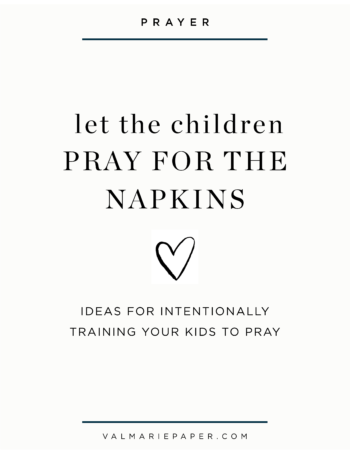In anticipation of her children’s book, Any Time, Any Place, Any Prayer releasing September 1, Laura Wifler joins us on the blog today!
 We’ve all been there. The family sits around the table, the food hot and ready to eat, and we ask, “Would anyone like to pray?” A kiddo’s hand shoots eagerly into the air. “Me! Me!” they yell. Grateful and relieved our question wasn’t answered with silence and avoidance of eye contact, we smile and nod, “Go ahead!” we reply. Everyone closes their eyes and clasps their hands. “Dear Lord, thank you for mommy, and daddy, and the table, and the lamp, and the potatoes, and the bowl, and the napkins…”
We’ve all been there. The family sits around the table, the food hot and ready to eat, and we ask, “Would anyone like to pray?” A kiddo’s hand shoots eagerly into the air. “Me! Me!” they yell. Grateful and relieved our question wasn’t answered with silence and avoidance of eye contact, we smile and nod, “Go ahead!” we reply. Everyone closes their eyes and clasps their hands. “Dear Lord, thank you for mommy, and daddy, and the table, and the lamp, and the potatoes, and the bowl, and the napkins…”
The first time (and particularly with our first child) this is adorable. We peek at our spouse and smile. It’s no big deal. I mean, we are grateful for all those things. But then this habit of naming everything in sight during prayer continues. For a few days it goes on, then weeks, maybe even on and off for years. Our other children do it too and we begin to wonder: Is this really okay? Do our children mean these prayers at all? Is letting this go on somehow sacrilegious?
As a mom to three young children, I know firsthand that praying with kids is always…an adventure. Before having children, I thought prayer was rather simple and straightforward. Prayer is just talking with God, right? Yet in parenting, we’re often faced with all sorts of new questions about what prayer actually is. You start to wonder what’s okay, and what’s not when approaching a holy God. Do we correct our children if things feel irreverent? What does it look like to teach our children how to pray? What felt like a straightforward practice starts to feel complicated.
In one sense, prayer is developed informally in a child’s life. . A natural product of any believer filled with the Holy Spirit is that they will know how to pray, when to pray, what to pray for, and overall they will want to pray. (Romans 8:15,16, and 26) Just like us, prayer will be something they naturally grow in. Over time they’ll realize there are many other ways to pray beyond rattling off a list of the things they see in front of them. Through being around other believers, involved in a church family, reading prayers in scripture—and particularly by watching you—they will see that prayer is so much more than a mindless list. I’ve taken great comfort as a mom that I can trust that the same Holy Spirit that works in my life, will work in my children’s, to grow and mature them out of rote, juvenile, or disingenuous prayers.
Yet in another sense, we can and should teach our children about what prayer is. Deuteronomy 6 reminds us that we’re to consistently teach our children what it means to follow the Lord and walk in his ways. In Matthew 28, Jesus charges us to “go and make disciples,” which includes the children in our own home. Part of raising children as a Christian parent is both formally and informally training them in the way of wisdom and the fear of the Lord. This means that as our children grow up, we take time to explain and unpack what we mean by prayer as “talking with God.”

Practically in our home, this has generally meant that we let our children pray for the napkins. We allow them to pray silly prayers or prayers that seem a bit irreverent, knowing it’s age-appropriate. The last thing we want to do is make our children feel self-conscious about their prayers. Instead of giving our kids a bunch of boundaries before they start to pray, or correcting them immediately after the fact, we let them pray however they will in the moment, trusting that God knows, understands, and loves the hearts of children.
Yet we take other moments, moments outside of formal times of prayer for our family, to explain and study prayer. Here are a few ways you can do this in your home:
- Talk about how prayer is to be genuine and thoughtful communication with God. We can speak to God as we might speak with a friend, or to mom and dad, sharing the things we care about, are worried about, or are afraid of.
- Talk about how God is interested in our real lives and cares—even though he knows it all, he wants to hear us share it with him.
- Take time to memorize passages of scripture as a family to give your children a language for prayer. As parents, we can trust that by storing up God’s word within our children, they “will understand the fear of the Lord and discover the knowledge of God,” (Proverbs 2:5) which will include a maturity in prayer.
- Take a few weeks to study the Lord’s prayer found in Matthew 6.
I think all of us would say that our children are typically more perceptive than they seem. This means the best thing we can do as parents is to simply model appropriate and genuine prayer for our children. They’ll pick up on whether or not we practice the type of prayer life we desire them to have. Pray for your children to have a sincere love for God and that he would draw them to himself. Don’t worry so much about the napkins. Trust God to do his work.
Laura Wifler is the co-founder of Risen Motherhood and serves as the executive director and co-host of the podcast. She is the co-author of the bestselling book, Risen Motherhood: Gospel Hope For Everyday Moments and the author of the forthcoming children’s book on prayer, Any Time, Any Place, Any Prayer (September 2021). Laura, her husband, and her three children live in central Iowa. You can find her on Instagram, @laurawifler or at laurawifler.com.





Leave a Reply
Comments (0)